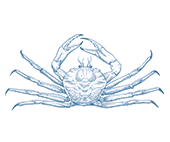




- Better Choice
Wild Caught
Region:
SA
- Southern calamari is a fast growing, short-lived and quick to reproduce species, although reproduction varies according to environmental conditions.
- Although no stock assessments have been conducted for this species, long-term catch records have been stable for over a decade, indicating the species is not at risk from fishing activity. Some evidence of potential localised overfishing will require careful management in future, however.
- Southern calamari are mostly caught using jigs or haul nets. These methods of fishing have minimal impacts on marine habitats or threatened wildlife.






To ensure they remain tender, squid and calamari should be cooked hot and fast in a pan, deep fryer or on a barbecue. Simply score, sear, and serve! Scoring with a knife in a fine crosshatch pattern allows the heat to penetrate quickly and keeps the flesh tender. When frying calamari, cook in small batches to ensure you don’t overload (and cool down) the pan, as this can result in rubbery stewed results. Calamari can also be slow cooked for hours in a sauce of tomato and wine for a delicious tender braise. Very fresh calamari can be finely sliced into ‘noodles’ and eaten raw.
- SA Marine Scalefish Fishery (408t in 2020)
Southern calamari is a fast growing, short-lived (around 12 months) species that reproduces quickly and produces a high number of offspring. Undertaking formal stock assessments (scientific assessments of the numbers of a species) of squid species is generally difficult for fishery managers, as reproduction is highly variable depending on environmental conditions.
Measures are in place to protect the stock, including closures to allow the species to spawn before capture, and catches reported in fishery records have been fairly stable over the past decade, indicating that the species is not currently at risk of overfishing. Despite this, there are some concerns indicated by declining catch rates in certain areas, combined with potential for a shift in fishing activity towards targeting southern calamari after recent fishery reforms, that will require careful management in future.
Southern calamari are caught mostly caught using squid jigs and in haul nets. Jigging is a low impact, highly targeted fishing method, which causes no disturbance to the seafloor and has almost no catch other species. Haul nets are used in coastal waters, and have minimal impacts on habitat or threatened marine wildlife. A small proportion of the SA catch (~10%) comes as byproduct in trawl fishing targeting western king prawns. That fishery has a Green GoodFish ranking, so is considered a sustainable source.
Marine parks throughout SA’s coastal waters provide a small but highly valuable additional protection for fish populations, bycatch species and endangered wildlife, and vulnerable habitats.


